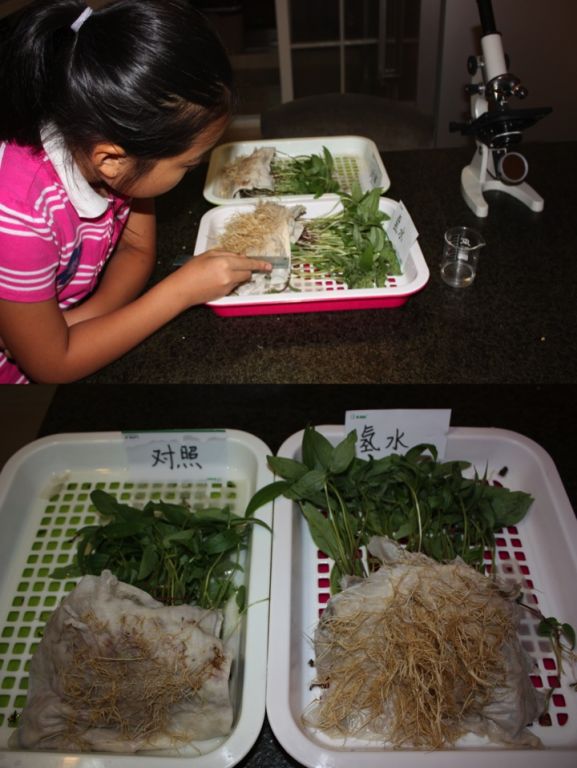博文
氢气促进植物不定根形成的机制
||
氢气生物学效应的研究已经成为国际研究热点,中国学者在氢气生物学效应方面有突出的贡献,众多医学研究学者参与了这一研究,目前已经发表相关SCI论文超过100篇,占国际这一领域的几乎50%。在氢气植物生理效应研究方面,中国学者的贡献是独一无二的,到目前为止,来自南京农业大学和中国科学院华南植物园的5篇相关SCI研究论文,先后从氢气提高植物抗逆能力,提高抗氧化酶,促进内源性氢气产生,促进生长素相关受体基因表达等方面作出突出贡献,奠定了氢气植物效应研究的基础,为氢气生物学效应机制的研究提供了新的研究表型。最近南京农业大学再发论文,阐述氢气可能通过一氧化碳信号系统参与植物不定根形成的调节。研究论文最近在线发表于Journal ofPlant Physiology。
氢气是一种内源性植物活性分子。尽管氢气曾经被认为属于生物学惰性气体,最近的大量研究提示氢气作为一种抗氧化剂可治疗多种动物疾病,并协助植物对抗环境应激。但是,氢气对植物根的形态模式是否可以调节仍不清楚。本研究中,来自南京农业大学的学者,用氢气水作用于黄瓜外植体,观察氢气的植物生理性作用,分析氢气在促进不定根形成过程中可能依赖的信号传导通路。研究结果显示,50%饱和度的氢气水溶液可以模拟氯化血红素的作用,氯化血红素是一氧化碳合成酶(血红素加氧酶1)的诱导剂,血红素加氧酶1在植物不定根形成过程中发挥关键作用。进一步研究发现,氢气的上述效应可以被N-1-naphthylphtalamic acid(一种生长素转运体抑制剂)阻断。氢气处理后黄瓜外植体血红素加氧酶1基因表达和蛋白水平均上调,氢气可诱导生长素信号和不定根形成相关基因的表达,这些基因包括CsDNAJ-1, CsCDPK1/5, CsCDC6, CsAUX22B样, CsAUX22D样都和血红素加氧酶1关系密切,血红素加氧酶1阻断剂锌卟啉可影响上述基因表达。上述作用可以被一氧化碳反转,进一步确定了血红素加氧酶1/一氧化碳在氢气诱导效应中作用的特异性。但另外一种著名的抗氧化物质维生素C对不定根形成没有影响,这提示氢气的效应可能和氧化还原平衡没有关系。总之,上述结果暗示氢气水诱导不定根至少部分通过血红素加氧酶1/一氧化碳信号系统介导。研究说明氢气可作为植物根发生的理想诱导剂。
全文学习:
![]() Hydrogen-rich water regulates cucumber adventitious root development in a heme o.pdf
Hydrogen-rich water regulates cucumber adventitious root development in a heme o.pdf

Hydrogen gas (H2) is an endogenous gaseous molecule in plants. Although its reputation is as a “biologically inert gas”, recent results suggested that H2 has therapeutic antioxidant properties in animals and plays fundamental roles in plant responses to environmental stresses. However, whether H2 regulates root morphological patterns is largely unknown. In this report, hydrogen-rich water (HRW) was used to characterize H2 physiological roles and possible signaling transduction pathways in the promotion of adventitious root (AR) formation in cucumber explants. Our results showed that a 50% concentration of HRW was able to mimic the effect of hemin, an inducer of a carbon monoxide (CO) synthetic enzyme, and heme oxygenase-1 (HO-1), in restoring AR formation in comparison with the inhibition effect conferred by auxin-depletion treatment alone. It was further shown that the inducible effect of HRW could be further blocked by the co-treatment with N-1-naphthylphtalamic acid (NPA; an auxin transport inhibitor). The HRW-induced response, at least partially, was HO-1-dependent. This conclusion was supported by the fact that the exposure of cucumber explants to HRW up-regulates cucumber HO-1 gene expression and its protein levels. HRW-mediated induction of representative target genes related to auxin signaling and AR formation, such as CsDNAJ-1, CsCDPK1/5, CsCDC6, CsAUX22B-like, and CsAUX22D-like, and thereafter AR formation (particularly in the AR length) was differentially sensitive to the HO-1 inhibitor zinc protoporphyrin IX (ZnPP). Above blocking actions were clearly reversed by CO, further confirming that the above response was HO-1/CO-specific. However, the addition of a well-known antioxidant, ascorbic acid (AsA), failed to influence AR formation triggered by HRW, thus ruling out the involvement of redox homeostasis in this process. Together, these results indicated that HRW-induced adventitious rooting is, at least partially, correlated with the HO-1/CO-mediated responses. We also suggested that exogenous HRW treatment on plants might be a good option to induce root organogenesis.
(结束)
补充:这个报道和我最近在家作的一个小实验相关,顺便在这里介绍。作为纯粹业余爱好,我最近在家指导女儿作了一个小小科学实验,我们发现氢气对促进植物根的生长具有不可思议的效果。采用绿豆幼苗为观察对象,每天给氢水和对照水浇灌不同的绿豆幼苗,从发芽率到叶片到根系数量长度等方面,每天都可以看到明显的不同变化,下图实验结束时拍的部分照片,上面有我女儿参与实验,因为她要把这内容写成小科技论文参加上海小学生的科技论文比赛,我这个对植物研究外行的教授爸爸指导,也十分吃力,多亏不少朋友的帮助才最终完成。贴这里供大家评判。

看大家喜欢,再放一些照片。下图是孩子纪录绿豆种子发芽数量。100个两组,氢气水处理影响发芽率。结果简单明了,孩子和她妈妈经过这次亲身实验,彻底信服了氢气的巨大效应。成为我的铁杆粉丝。

左侧为对照组,右侧为实验组。照片远处约10公里处为东方明珠,但看不到。

https://blog.sciencenet.cn/blog-41174-742254.html
上一篇:嗜赌如命的科学证据
下一篇:美国年轻学者如何通过学术会议找工作